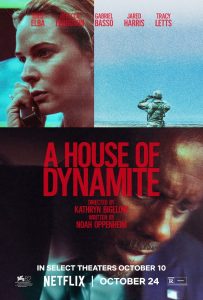
“A House of Dynamite”
(USA)
Metacritic (6/10), Letterboxd (3/5), Imdb.com (6/10), TMDB.com (6/10), Imdb.com critics review
#BrentMarchant #AHouseofDynamite #KathrynBigelow #nuclearmissile #Chicago #IdrisElba #TracyLetts #JaredHarris #JasonClarke #GabrielBasso #nuclearconflict #FailSafe #DrStrangelove #WarGames #TheDayAfter #Threads
Nuclear conflict is one of those subjects that’s almost too big to think about despite the possibility of its occurrence being something we can’t and shouldn’t ignore. Unfortunately, then, it’s frustrating when a film comes along that might help to shed some light on the subject but that leaves viewers not entirely clear what to make of it. Such is the case with this clumsily constructed offering from Oscar-winning director Kathryn Bigelow. The picture, told from different perspectives in three overlapping chapters, follows the developments associated with a single mysteriously launched nuclear missile headed for the US mainland and the efforts to determine who fired it and how it might be contained. The first chapter primarily chronicles the efforts of the military and the staff in the White House Situation Room. The second looks at the event from the perspective of Strategic Command. And the third follows the impossible decision-making process left in the hands of the President (Idris Elba). Over the course of these interlocking segments, viewers are introduced to the gut-wrenching issues thrust upon the Secretary of Defense (Jared Harris), the head of Strategic Command (Tracy Letts), the Deputy National Security Advisor (Gabriel Basso) and the Situation Room chief (Jason Clarke) as they attempt to sort out what to do, determinations that are fundamentally greater than any of them are capable of addressing realistically, let alone satisfactorily. It’s a frightening scenario, to be sure, as the missile comes ever closer to striking its target, Chicago, a calamity projected at killing upwards of 10 million. Regrettably, though, the format chosen to tell this story does little to clarify matters for audiences. Given the many characters and diverse locations involved in the narrative, as well as the pervasive jargon, numerous shorthand acronyms and underexplained policy options that pepper the needlessly complicated screenplay, one practically needs a scorecard or flow chart to keep everything straight, making the film more of a chore to watch than a vehicle designed to offer insight and enlightenment. Sadly, there are no winners in circumstances like this, and the picture, to its credit, makes that point abundantly clear. However, when it comes to leaving a hard-hitting, truly meaningful, scared-down-to-your-socks impact on those who watch this release, the goal is not achieved nearly as well as in any number of other offerings, such as “Fail Safe” (1964), “Dr. Strangelove” (1964), “WarGames” (1983), “The Day After” (1983) or “Threads” (1984), all of which make clearer, better defined viewing choices than this film. In the end, when it comes to the feasibility of engaging in nuclear gamesmanship, one can’t help but be enlightened by the astute observation presented in “WarGames,” the notion that “the only winning move is not to play,” a message that “A House of Dynamite” attempts to echo. It’s just unfortunate that it doesn’t do so nearly as well as its predecessor, particularly given the stakes involved.



